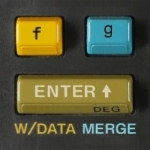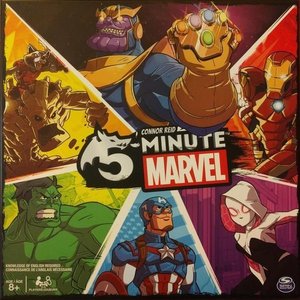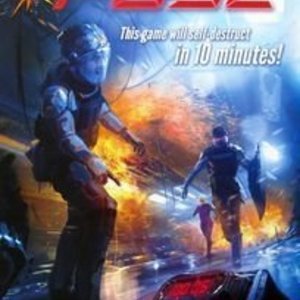Purple Phoenix Games (2266 KP) rated 5-Minute Marvel in Tabletop Games
Jun 12, 2019
Ok so here’s the quick rundown. Setup is almost as long as the entire game, but needs to be reset with every subsequent play. You have the individual hero decks for each player, a LARGE resource deck, and a mission deck to divvy up and shuffle each time. It’s not difficult to keep it all straight, but you are given a LOT of cards to handle. Once the decks are all setup you are ready to play. I downloaded the 5-Minute Marvel timer app to accompany my game plays, but that’s completely unnecessary (I do like it though). Start the timer, and then flip over the first card of the mission deck on the boss’s mat. Each card will have several resource icons that the heroes will need to discard from their hands to overcome the card. There are no “turns,” as all heroes are attempting to gather the necessary resources at all times. Each hero has a special ability they can use that is printed at the bottom of their play mat, and they are very powerful, so use them often! If you can get through the entire mission deck and defeat the boss within the 5 minute time limit, you win! Since the game lasts only 5 minutes you should probably play it several times in a row using different bosses of the six that come with this base box.
Components. This game is a combination of thick cardboard play mats for heroes and bosses and linen-finish cards for everything else. The quality of the cardboard and the cards are both pretty good, so I have no issues here. The art on the game is really spectacular. I have not really seen Marvel art like this and it is very refreshing. It is somewhat cartoony and not very gritty at all (which seems to be the comic book trend). Definitely a positive for me.
Do I love this game? Um, no. Maybe with more and more plays with different playmates it will grow on me, but the several times we played it we had a great time and it was very stressful to acquire the needed cards, or to decide to use your special ability, but we never once failed. I know we can increase the difficulty and use higher-ranked bosses. AND WE WILL, but the first few bosses are pretty much chumps and we had no problems dispatching them. I do believe this game would benefit from lots of expansions, but I do not know how successful the base has been for the publisher, so that may never come to fruition.
I do recommend you try out this game, as the frenzied rush to beat the clock is something I very much enjoy in games (a la FUSE, Escape: The Curse of the Temple, et al). Also: it’s Marvel. The game unfortunately does not come with Dr. Strange nor Iron Fist like I would have preferred, but it DOES come with a couple of my other favorites: Ms. Marvel and Squirrel Girl. They are so so fun! Purple Phoenix Games is pretty consistent with this one (even my wife agrees!) and we give this a frantic 12 / 18. Go get ’em Cap!
https://purplephoenixgames.wordpress.com/2019/04/30/5-minute-marvel-review/
Purple Phoenix Games (2266 KP) rated FUSE in Tabletop Games
Jun 12, 2019
FUSE is a fast-paced game where a bomb squad is working against the clock to diffuse a number of bombs discovered on their ship! The goal is simple: diffuse all of the bombs before they explode. The gameplay, however, is a little bit more complicated. While there are a few minor differences between group- and solo-play, the basics of the game are unchanged – players roll and place dice in unique combinations to ‘diffuse’ each card. If all cards are diffused in the 10-minute time limit, then the game is won! And if not…then I think you know what that means. BOOOOOOOOOM!
Having played and enjoyed FUSE in both a group and solo setting, I think I can honestly say that I miiiight like it a little more as a solo game. My main reason is purely selfish – playing alone means that I don’t have to share dice. In a group game, the dice are rolled and divvied up between all of the players. Playing solo means that I can keep all of the dice for myself! And, theoretically, that means that I should be able to diffuse my bomb cards more quickly since I have more dice with which to work! Gone is the agony associated with sacrificing dice to other players – they’re all mine! Yeah, I have to deal with all of the bombs by myself too, but not having to share my materials makes the job seem easier even though it might not necessarily be any easier.
For me, one of the most challenging parts of playing FUSE solo is the real-time countdown. I know, I know, the timer is one of the most integral parts of this entire game. However, the pressure of a time limit is stressful and it makes me a sloppy player – dropping dice, knocking over towers, etc. Some lucky people have been blessed with the ability to remain calm under pressure, but unfortunately I am not one of them. I hope you don’t misunderstand my grievance with the timer for disliking the overall game, though. Having a timer adds an element of excitement that creates such a high-energy atmosphere, even when playing solo. I’m literally just rolling and placing dice, but with a ticking clock, I’m on the edge of my seat with adrenaline pumping as I try to complete my cards as quickly as possible! With every play, I’d like to think that I have gotten better at managing the pressure of the timer, even though that may not necessarily be true…
I do thoroughly enjoy playing FUSE as a solo game. Since time is of the essence, the game forces me to be creative with my dice placement and I must constantly be changing my strategy based on which dice I draw and what cards I have before me at any given time. If you are looking for a high-energy game, even when playing solo, look no further than FUSE. It will certainly keep you on the edge of your seat and will keep you engaged in the action until the game ends – either in celebration of success or a fiery explosion!
https://purplephoenixgames.wordpress.com/2019/02/18/solo-chronicles-fuse/
Purple Phoenix Games (2266 KP) rated Trust Me, I'm a Superhero in Tabletop Games
Oct 8, 2020
Trust Me, I’m a Superhero is a negotiation-style party card game in the vein of Apples to Apples. In it players are bogus superheros answering the Call for Help and attempting to convince the Director to send them out as the city’s hero.
DISCLAIMER: We were provided a prototype copy of this game for the purposes of this review. These are preview copy components, and I know for sure that the final components will be different from these shown. I usually include a messy photo as my last of the review, but in this case I captured the art style that will be used in the final version. You are invited to back the game through the Kickstarter campaign launching October 27, 2020, or purchase through any retailers stocking it after fulfillment. -T
To setup, shuffle the Super deck and Power deck separately. Deal each player five cards from each deck and the game may begin!
Playing Trust Me, I’m a Superhero is incredibly simple. From the hand of 10 cards dealt players will choose one Super card and one Power card to mash together creating a lame superhero. Players will display their superhero face-up in front of them. The player who is the current Director will flip over the top Call for Help card, read it aloud, and then players will initiate discussion with the Director to convince them that their hero should be sent to answer the call. The Director then chooses the best superhero by awarding the Call for Help card to the winning player. The next player in clock-wise order is the next Director. Play continues in this fashion until a player has won three Call for Help cards or some other determined time limit.
Components. Well, I cannot really comment on the components too much as again, I am using a prototype copy with prototype non-final artwork. From the photo below of the art style the final game will be using I can see that the art is whimsical and cartoony, which is perfect for this game. I am also sure that components will probably be upgraded as a result of a successful Kickstarter campaign with crushed stretch goals.
I have also played and reviewed Trust Me, I’m a Doctor and I said that I liked it, and I do. But if I like Trust Me, I’m a Doctor then I love Trust Me, I’m a Superhero. Just the added little twist of choosing your Super and Power cards BEFORE you see what the Call for Help will be is excellent. This game would be so different if you saw the Help card prior to assembling your Super Power. It would be too easy and not at all hilarious. I am so glad this twist exists and helps to elevate this from a good game to a great little A2A spin-off that CAN get NSFW with the right (or wrong?) people, and will feature some fun art. If you are interested in this little title, please consider backing it on Kickstarter on October 27, 2020! Tell them Purple Phoenix Games sent ya or I’ll send over Solar-Powered Punch or Seductive Corpse to rough you up a bit.
Purple Phoenix Games (2266 KP) rated Never Say Never in Tabletop Games
Jan 22, 2021
Never Say Never is a party card game in the same vein as Never Have I Ever, but plays oppositely. So gather your friends (well, up to 20 of them and only after COVID passes by) and get ready to amaze them all.
DISCLAIMER: We were provided a copy of this game for the purposes of this review. This is a retail copy of the game, so what you see in these photos is exactly what would be received in your box. I will describe the overall game flow and major rule set so that our readers may get a sense of how the game plays. Like what you read? You may purchase a copy online or from your FLGS. -T
To setup, have each player draw five cards from the massive deck. You are now ready to play!
On a turn the active player will choose one of their cards to be played to the table. When read aloud, the active player will score one point if everyone says they would never do the action played. If people say they WOULD do the action, however, they immediately explain themselves and why they would or how they have in the past. The greatest story wins the point. The first person to 10 points wins the game or is very drunk (if playing by the alternate rules).
Components. This game is about a million cards in a box with the rules of the game printed on the back of the box. The cards are all fine quality and minimal art is used, but the layout is decent and legible. No real problems to be had with components.
The game itself isn’t what I would call “bad.” In fact, it is enjoyable for what it is: a simple party game offering some new and imaginative prompts for when your brain cells aren’t necessarily firing correctly. Instead of coming up with the prompts from experiences you have actually had, these offer off-the-wall scenarios that many people have not done, but may actually consider. A small change, but an interesting one.
Obviously this one probably will not rank highly on many gamers’ favorite lists, but I think it is one that is handy to keep around when something of this style is needed. I know there have been times when the game night invitee list was bloated with non-invitees and I had to scramble to come up with some engaging activities. Never Say Never would certainly have saved my bacon on those occasions. Especially when non-gamer spouses are added to that number.
So I think that if you are a fan of party games and want to try a spin on an old standard, give Never Say Never a shot. If, like me, you struggle to entertain the non-gamers who show up to game night, give this a try. You might very well open up some peoples’ minds to other games that night as well. Purple Phoenix Games gives this one an 11 / 18. I personally would never eat rat meat, but under the right circumstances would certainly consider shaving my eyebrows completely off. HBU?

St.George Mobile Banking
Finance and Reference
App
St.George Mobile Banking is designed to give customers full banking functionality in an easy to use,...

RPN-67 Pro
Productivity and Utilities
App
A dream calculator of the 70's, priced at $1,900 in today's dollars, now on your iPad! RPN-67 Pro...

ANZ goMoney New Zealand
Finance
App
ANZ goMoney New Zealand makes it easy to keep track of your money, make secure payments to anyone...

Pic Collage - Photo Editor
Photo & Video and Education
App
Download the best app for easily editing photos and creating photo grids and collages for the fall...

Vintage Design Logo Maker - Poster & Logo Creator
Business and Productivity
App
••• We are over 6000 5-star rates in the US Store alone, thanks for your support! •••...
Purple Phoenix Games (2266 KP) rated Villagers in Tabletop Games
Jan 16, 2020
Disclaimer: I do not intent to rehash the entire rulebook in this review, but rather provide an overview of the gameplay, and how it differs between multiplayer and solo play. -L
Villagers is a game of card drafting and tableau building in which players are competing to build the most prosperous village in the land. The game is played over a series of rounds, each broken up into the Draft Phase and the Build Phase. During the Draft Phase, players take turns drafting villagers from the available card stacks into their hands. During the Build Phase, players can add villagers from their hand to their tableau. Certain cards can be chained together, and provide more powers and/or end-game points – but they must be added to the village in chain order. At two points throughout the game, the First and Second Market Phases, all players will collect money depending on which cards they have in their villages. The game ends immediately after the Second Market Phase is completed, and the player with the most money is the winner!
As a solo game, Villagers plays very similarly to group play, with only a couple of differences. First, the solo player is battling against The Countess, an AI character, to create the best village. The Countess is incorporated into the game in a unique way. During the Draft Phase, whenever you draft a villager to your hand, you also select an available villager to go straight into the village of the Countess. The Build Phase is carried out as normal. At the end of every round, you blindly draw a face-down card from the Reserve (draw deck), and it automatically goes into the Countess’ village as well. The other twist to a solo game of Villagers is that there are Event cards in play each round. Events are resolved after the Build Phase, before beginning the next round, and are often detrimental to the player – like making you pay extra gold to unlock padlocks, for example. The First and Second Market Phases work the same as they do in a multiplayer game, and the game ends immediately after the Second Market Phase. If you have managed to accrue more money than the Countess, then you have won!
I want to start off by saying that I love Villagers. Card drafting and set collection are my JAM, and this is a game that highlights those really well without making it too complicated. Even when playing solo, those mechanics still feel balanced, and that makes the overall game enjoyable. From my previous Solo Chronicles, I have stated how much I dislike “Beat your own high score” solo modes, so I was extremely happy when I saw that Villagers pitted the solo player against an AI character – the Countess. For the most part, I think that the Countess works really well in this game. When you draft a card, the Countess gets a card as well. But the best part about that is that you get to choose which card goes to the Countess. That means that you are able to keep some semblance of strategy in your game, because you have the power to decide what cards go where, for the most part.
The other neat thing about solo play is the inclusion of Event cards in the game – which are not present in group play. The Events add an extra element that you have to take into account for the given round. Depending on the Event, it could compromise your strategy quite a bit, but that’s what keeps it interesting. You can’t just get into a groove and grind through the rounds, drafting everything you want, when you want. You have to adapt your strategy based upon the Event(s) in play, and the Countess’ village.
The only downside for me is that at the end of every round, the Countess gets the top face-down card from the Reserve, and depending on what card that is, it could throw a wrench into the strategy you’ve been working hard to set up. I guess that mimics a multiplayer game in a sense, though, because you can’t always control what your opponents will do. The biggest downside about solo play for me has nothing to do with actual gameplay, but rather table space. Every card that goes into the Countess’ village is a stand-alone, meaning that they do not chain together like cards in your village will. So depending on how long the game goes, the Countess’ village will get to be pretty large, and hog lots of the table. I think that just means I need a bigger table though…
All that being said – is Villagers a good game for solo play? I would say mostly yes. Strategy is still required for success, but adaptability of that strategy is what keeps the game engaging and entertaining. Nothing can quite replace the multiplayer experience, but playing against the AI character keeps the competitiveness alive in the game. As someone who does a lot of solo playing these days, I am glad that I have added Villagers to my collection. If you haven’t gotten a chance to play Villagers yet, I would highly recommend checking it out. Solo or multiplayer, it’s a great time!




